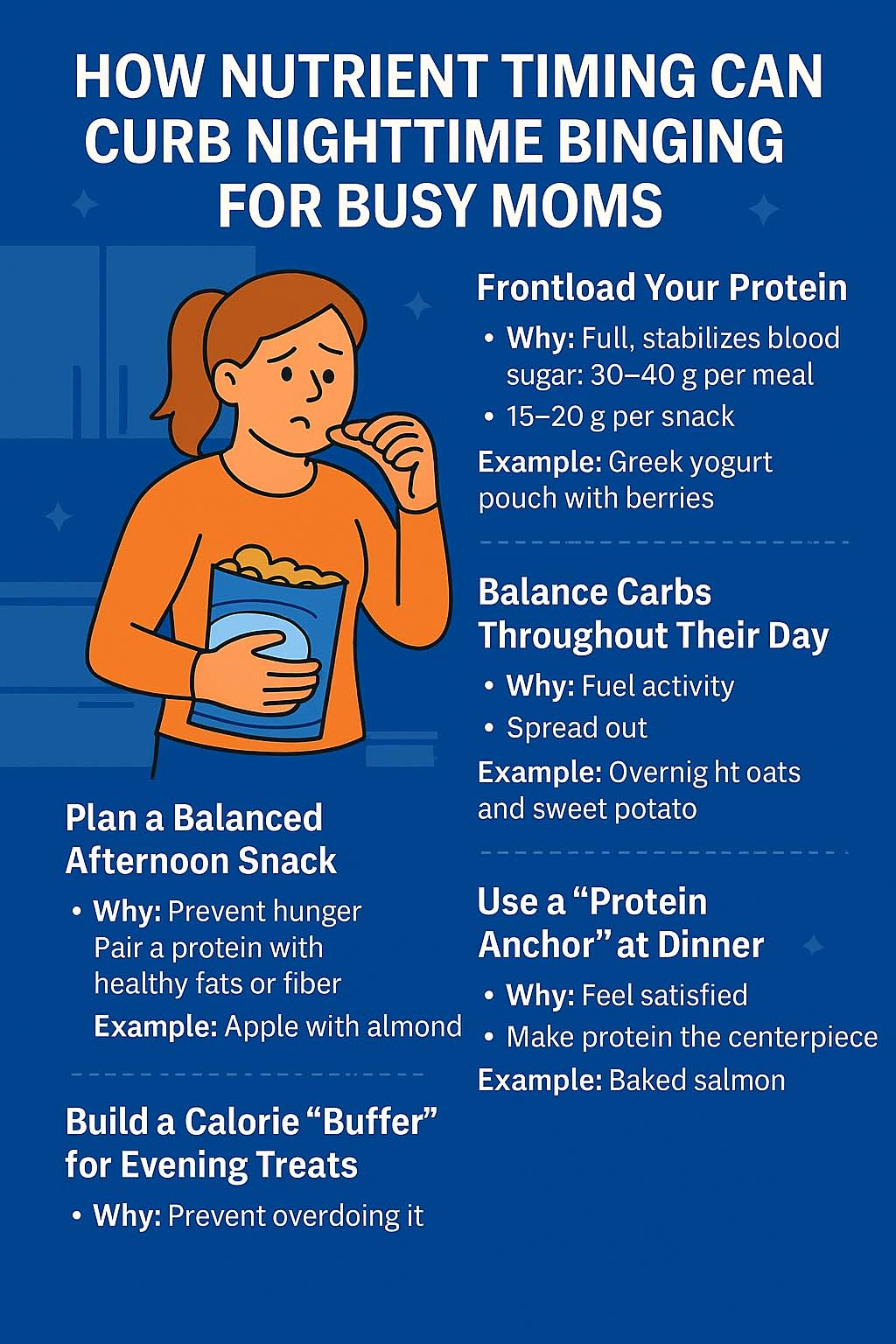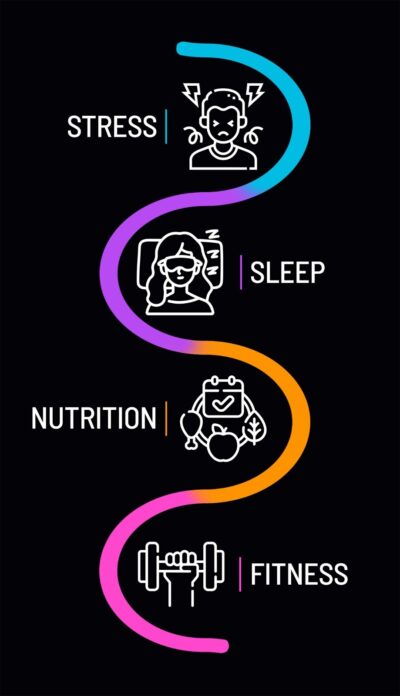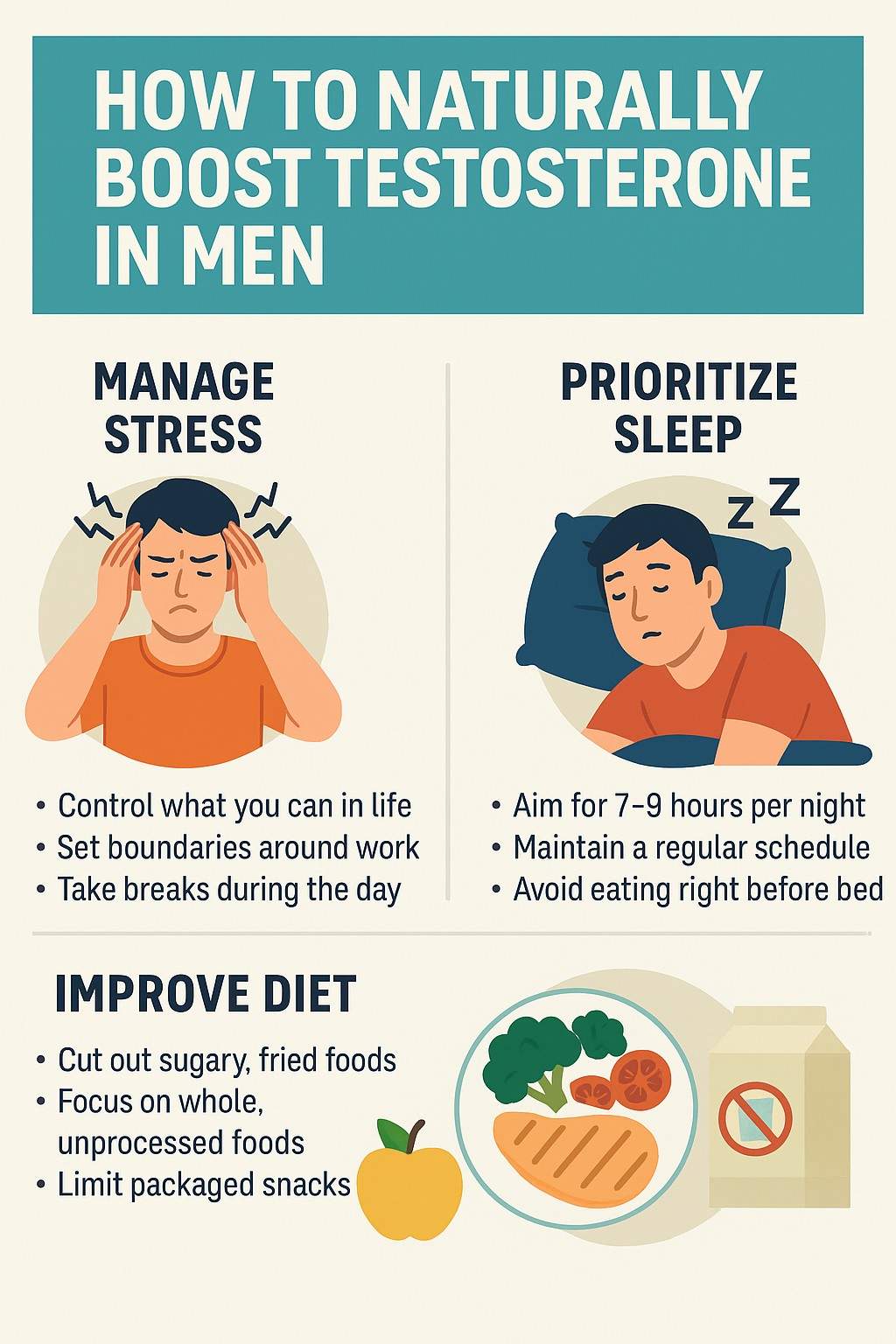
In this guide, personal trainer & NASM-certified nutritionist Baltazar Villanueva explains how busy moms can use nutrient timing to avoid food binges after the kids go to bed.
Your alarm goes off… and you think, “Five more minutes.” Big mistake.
Now it’s go-time:
- The kids need breakfast, lunches packed, teeth brushed, hair fixed, and backpacks found.
- One can’t find their shoes, the other is crying because their favorite shirt is in the laundry, and your husband can’t seem to find the coffee filters you’ve kept in the same cabinet for eight years.
By the time you get everyone out the door, you’ve played referee, short-order cook, laundry ninja, and Uber driver, and you haven’t eaten a single bite. Breakfast? If you’re lucky, you get to drink your coffee before it goes cold. More often, it’s half a granola bar leftover from your kid’s plate or whatever you can grab while buckling a car seat.
The rest of the day doesn’t slow down. There are work calls, school drop-offs and pick-ups, errands, sports practices, homework help, and somewhere in there you realize you’ve been running on caffeine and willpower since 6 a.m.
By the time you finally walk through the door for the last time that day, you’re starving. That’s when the pantry raids, fast-food runs, and “just one more bite” moments kick in. Then after the kids are in bed? Well… that’s your time, and nothing pairs better with Netflix than snacks and maybe a couple glasses of wine.
The next morning, it starts all over again.
Why This Keeps the Baby Weight Hanging Around
Nighttime overeating isn’t just about “lacking willpower” after the kids go to bed. It’s the result of how your day has been set up. In most cases, it ties back to four foundational habits that are getting pushed to the back burner. Here is what you need to do to stop the after-hours snacking and finally drop the weight.
1. Reduce Your Stress
Motherhood is basically an extreme sport. When stress runs the show, your body pumps out more cortisol, a hormone that ramps up cravings for quick, calorie-dense comfort foods. By the time you get home, you’re mentally drained, your decision-making tank is empty, and your brain is screaming for that dopamine hit from food.
If you reduce your stress load, it greatly increases your chance to resist cravings, or not experience them at all.
2. Get Quality Sleep
Let’s be honest – moms laugh in the face of “8 hours of uninterrupted sleep.” Nighttime feedings, sick kids, or staying up late for your only slice of quiet time mean your hunger hormones (ghrelin and leptin) are all over the place. You wake up already behind, grab something sugary, and ride the blood sugar rollercoaster until bedtime.
But if you prioritize quality sleep, it puts you on a better track to avoid food binging. Going to sleep earlier obviously renders you unable to physically eat late into the night, and it helps keep your hormones stabilized.
3. Focus on Whole Foods for Nutrition
Quick, kid-friendly foods might keep you going, but they rarely keep you full. High-calorie, low-nutrient snacks like crackers, cookies, and even most “protein” bars, leave you hungry again within hours. It’s how you can feel like you “barely ate” but still end the day in a calorie surplus.
When you eat whole foods that are protein-rich, you’ll fuel your body throughout the day without excessive calories.
4. Work Out 2–3 Times Per Week (Full Body)
Chasing toddlers and hauling laundry baskets is an activity, but it’s not strength training. Building muscle improves insulin sensitivity, helps regulate appetite, and boosts your mood. Without it, your body is less efficient at handling the calories you eat, and fat loss slows to a crawl.
I recommend full-body strength training 2-3 times per week, using either weight, resistance bands, or a combination of both. Cardio helps too, but I usually recommend getting it in the form of walking (10,000 steps a day) instead of running or jogging.

How Nutrient Timing Can Help
You don’t have to cook elaborate meals or carry a food scale in your diaper bag. You just need to give your body the right fuel – at the right time – so you’re not walking into the evening starving and ready to eat the pantry door.
1. Frontload Your Protein
- Why: Protein keeps you full, stabilizes blood sugar, and helps prevent the late-night snack spiral.
- How Much:
- Men: 40–50g per meal, with snacks around 20g.
- Women: 30–40g per meal, with snacks around 15–20g.
- Pro Tip: If you’re using a protein bar, aim for 1g of protein per 10 calories to keep it in check.
- Busy Mom Example: Greek yogurt pouch with berries for breakfast, rotisserie chicken with quinoa and veggies for lunch.
2. Balance Carbs Throughout the Day
- Why: Carbs fuel your brain and body—not just workouts.
- How: Spread them across your meals, and on days you’re less active, scale them down if you want. The key is listening to your body’s needs.
- Example: Overnight oats in the morning, sweet potato at lunch, smaller carb portion at dinner.
- Tip: Stick to whole-food carbs (fruits, veggies, whole grains) and minimize processed snack foods.
3. Plan a Balanced Afternoon Snack
- Why: Prevents the “hangry mom” dinner rush.
- How: Pair a protein source with healthy fats or fiber.
- Example: Apple slices with almond butter, cottage cheese with pineapple, or beef jerky with carrot sticks—bonus if you can eat it during kids’ snack time.
4. Use the “Protein Anchor” at Dinner
- Why: Starting with protein helps you feel satisfied and less likely to graze afterward.
- How: Make protein the star—chicken, fish, lean beef, or tofu—and add veggies and a moderate carb side.
- Example: Baked salmon, roasted veggies, and a small portion of rice.
5. Build a Calorie “Buffer” for Evening Treats
- Why: Cutting all treats often backfires.
- How: Leave 100–200 calories for a snack you enjoy, guilt-free.
Example: A small bowl of popcorn, Greek yogurt with honey, or a square of dark chocolate.
The Bottom Line
When you hit your protein goals, balance your carbs, and plan your day so you’re not arriving at dinner on empty, you break the cycle of nighttime binging. Pair that with the four pillars – stress management, better sleep, whole foods, and strength training – and you’ll finally start shedding those stubborn post-baby pounds. If you’re still struggling to be motivated, try gamifying your nutrition.
Stop obsessing over the scale. Find a strategy that actually works.
If you are interested in learning more about nutrient timing or my services with nutrition coaching and personal training for women, contact me for a free consultation.
About the author : Baltazar Villanueva

Baltazar Villanueva is a NASM certified personal trainer & nutritionist that provides services to the Denver metro region. Formerly a mixed martial arts fighter and self-defense trainer, he now provides clients with customized fitness programs that address whole-body wellness. Book a consultation with him here to get started on your fitness journey.




